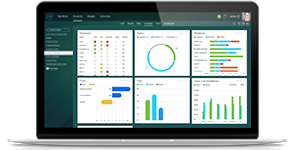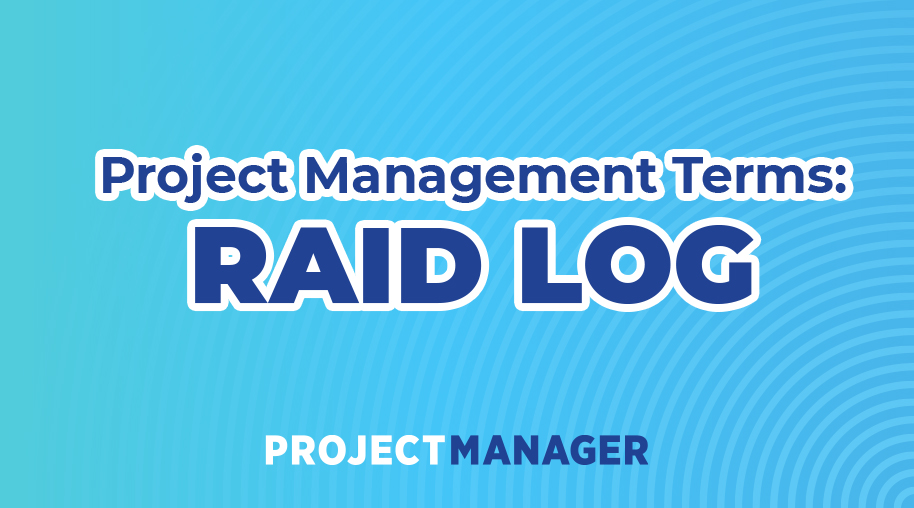What Does Raid Stand for Project Management
What Is a RAID Log and Why Should I Use One?
ProjectManager.com 

Spot risk before it becomes a problem. Try ProjectManager.com's real-time tracking and reporting features to get a grip on your projects. It's free for 30 days.
Learn More About Our PM Software
Every project has its issues. Issues being problems that arise during the execution of the project. Plan as thoroughly as you like, you're still going to face problems, even if you use project planning software. Problems during a project are a given, and solving them in real time while maintaining project progress is a real challenge.
Risks are a bit different than issues; risks are issues that haven't happened yet. By identifying what risks are probable, you can prepare for them and have a response in place if and when they show up in your project.
But once the plan is in place, and you've detailed all the risks likely to occur over the life cycle of the project, the next step is having a system in place to monitor and track the risks that might happen, and the issues that do. That's called risk or issue management. But you can take that management even further by using what's called a RAID log.

What Is a RAID Log?
RAID is an acronym that stands for Risks, Actions, Issues and Decisions.
- Risks are the potential problems lurking in your project. Risks tend to be thought of as having an adverse impact on the project, but there are also positive risks.
- Actions are what you need to do throughout the project.
- Issues are when something goes wrong in the project. If an issue isn't managed and resolved it can derail the project or cause the project to fail.
- Decisions are how you decided to act in the project.
A RAID log, therefore, is a project management tool that tracks risks, actions, issues and decisions. It's a simple way to organize this information and comes in handy during meetings and project audits.
How to Use a RAID Log
A RAID log is fairly simple to use. You just fill in information for the four topics listed above.
Risks
With risks, you list those that think might occur over the life cycle of the project. For each of the risks you note the probability of it actually happening. Then write what actions you plan to take if it does show up and how those actions will resolve it.
Each risk should be given an owner who is responsible for catching the risk if it becomes an issue, and for implementing the plan to resolve it. You can also set up review dates to monitor the progress of that fix or just check-in occasionally to see if the risk has increased or decreased in its likelihood.
Actions
For the actions section there needs an owner, too. The owner would be assigned to every action that you listed that needs to be done. Having an owner makes sure that the action is managed and will not fall through the cracks of a busy project.
The actions, whatever they are, need to be charted. That is noted the date they are completed. During project meetings, refer to this list and check off those actions that have been completed to make sure there's been follow through.
Issues
Issues come up in a project, and each one needs to be clearly identified here. Note what the plan is for dealing with the issue, who is going to lead that initiative, what the schedule for review will be and how it will be marked done when resolved.
Decisions
As for decisions, again this is merely a list of decisions that need to be made over the course of the project. Consider it a way to collect the thought process of the project, a record of what decisions were made, who made them and why.
As you can see, a RAID log is merely a method for keeping all this information organized and easily managed during the project. It's not hard to learn but it can be somewhat of a hurdle to clear at first. But once you get used to keeping a paper trail of these four topics, it'll become second-nature and prove an asset.
Pros and Cons of Using a RAID Log
There is never a magic bullet that can pierce all problems, and a RAID log is no different. There are pros and cons to using one.
Pros
The most obvious benefit is that a RAID log makes you think in an organized and strategic way about a project. It helps you collect a mass of data that would be highly unlikely to remain in one's head without some method to collect them.
Consider the RAID log a shortcut, and any busy project manager will appreciate that, as time is precious when managing a project. It's also a shortcut for communications, as the information you gather is not easily disseminated to those who need to know it.
Piggybacking on that pro is the fact that a RAID log helps you maintain control over the project. Most questions you might get from a stakeholder are going to be answered in the RAID log, which means less running around trying to figure things out.
Basically, you're controlling the data of your project so it's easily accessible. There's always a lot of information spinning around the project, so this is an asset. Plus, as risks materialize and issues arise, you have a system to control and monitor them, so they don't sideline the project.
The RAID log is a template to capture those plans and, better still, a ruler to measure how effectively they're being carried out. With every risk having a project member responsible for identifying and resolving it, you're going to, again, have more control over the project and the process of risk management.
With a RAID log you're decision-making is more consistent. A project is made up of a swarm of decisions, and that's just in one day, so while there are minutes in meetings, the RAID log captures those decisions that are taking place in a more informal setting. Now you and your stakeholders have a detailed record of all the decisions that occur over the life cycle of the project, with reasoning as to why they were made, when and because of what.
What assumptions were made during the project? There are plenty, but now you don't have to rely on someone's memory to retrieve them. While some might be unimportant, others are not, and it is not always clear at the time which is which.
Cons
Sometimes, on a larger project, the RAID log will have to be reviewed often. The frequency of these reviews can make it feel as if you're constantly looking over the RAID log.
Therefore, it's easy to get lost in the details. So, the best way to approach a RAID log is by having a good idea of how deep into the woods you want to go with each of these subjects. Too far and you're going to bog down and miss the important stuff. But if you're too cursory in your approach, then it defeats the purpose of the RAID log and virtually renders it useless.
What is too much information and what is too little? That can often be clearest in hindsight, though, and you don't have the luxury of managing a project backwards. You can prioritize the issues as high or low, which is one way to determine how much data will be required.
Also, you need to approach each section of your RAID log with a different mindset. Issues are different than risks, for example. Maybe you want to keep a series of RAID logs, one for each section, rather than combining the four categories into one log.
Software Can Help Turn Cons into Pros
A RAID log could be as simple as a spreadsheet. All you need is a place to save the collected data. But that's the minimum, and if you have a more dynamic software then you have a more dynamic RAID log.
Project management software was developed to make project managers and their teams work more efficiently and productively, and that same technology can be applied here to help run a RAID log more efficiently.
With the right software you get help tracking risks, progress and changes in your project. For example, with an online project management software you get real-time data, which means you're seeing the project as it is, not where it was.
With a real-time dashboard you have a set of metrics for measuring progress and tracking risk, issues and more. So, it's not a problem access the RAID log.
The details can be automated by the software, and edited as needed, plus it's easy to prioritize. With the dashboard you get this information in easy-to-read graphs and charts. These can then be filtered to show just the data you want.
ProjectManager.com can make the useful RAID log even more useful by making it simple to track the issues, risks and more in your project. Its cloud-based software has tools such as a real-time dashboard and offers a collaborative platform making it easy for team members to update their status, so you're always getting a current view of the project. Try it for yourself and see by taking this 30-day trial.
Related Posts
What Does Raid Stand for Project Management
Source: https://www.projectmanager.com/blog/raid-log-use-one
0 Response to "What Does Raid Stand for Project Management"
Post a Comment